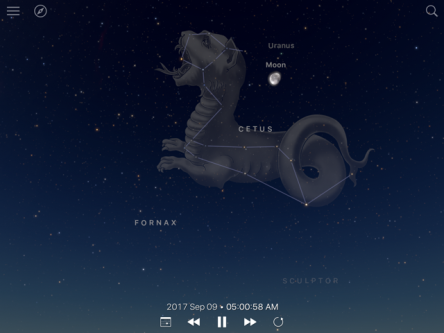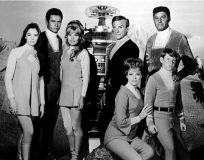

• Sept 3rd – The Viking 2 landed on Mars this day back in 1976.
• Sept 5 – Neptune, the 8th planet in our solar system, reaches opposition at 12:00 A.M. CDT, opposition is the point in an outer planet’s orbit where it lies opposite the Sun as seen from here on Earth. If you were “above” the solar system and looking “down”, then you would see an alignment like this: Sun->Earth->Neptune. When a planet is at opposition it rises at sunset and stays up all night, crossing the meridian (the imaginary circle around Earth that connects the North and South Celestial Poles) at midnight, and is generally at its closest point to us for the year. Opposition is regarded as the best time to observe the planet with optical aid. On dark, moonless nights you can see it with binoculars. Small telescopes will show its bluish color. The blue is a result of methane in Neptune’s atmosphere. The methane is very good at absorbing the redder portions of the Sun’s light and bouncing back the blue portions to our eyes.
Voyager 1 probe was launched this day back in 1977.
• Sept 6 -The Moon passes within 0.8 degrees of Neptune at 12:00 A.M. CDT. One degree is the width of your pinky pinker held out at arm’s length.


• Sept 8 – Star Trek TOS, premiered on TV this day back in 1966.
• Sept 9 – Free public star party at Pinnacle Mountain State Park Visitor Center with the members of the Central Arkansas Astronomical Society, 8:00 P.M. – 10:30 P.M. Subject to cancellation due to weather. For more info, go to www.caasastro.org

The Moon passes just 4 degrees to south of Uranus at 5:00 A.M. CDT.

• Sept 12 – Mercury reaches its greatest western elongation in our eastern sky at 5:00 A.M. CDT, look for the planet at around 6:00 A.M, before the Sun rises. Greatest elongation refers to the planet being at its greatest angular distance from the Sun, in this case, 18 degrees (it can be as much as 28 degrees). This will be the best morning appearance of the elusive planet Mercury all year. You can see it with the naked eye but a pair of binoculars or a small telescope will enhance the view.
• Sept 13 – Last Quarter Moon officially occurs at 1:25 A.M. CDT. The Moon is at perigee, its closest distance for the month, at 229,820 miles away, at 11:06 P.M. CDT.
 • Sept 15 The Cassini spacecraft will end its nearly 20 year-long mission at Saturn by plunging into the planet’s atmosphere. Find out more about Cassin’s Grand Finale here: https://saturn.jpl.nasa.gov.
• Sept 15 The Cassini spacecraft will end its nearly 20 year-long mission at Saturn by plunging into the planet’s atmosphere. Find out more about Cassin’s Grand Finale here: https://saturn.jpl.nasa.gov.

Lost in Space TV series premiered on this day in 1965.
• Sept 16 – Monthly Club Meeting of the Central Arkansas Astronomical Society at the River Ridge Observatory. Supper Bowl at 6:00 P.M. ($5/person), programs at 7:00 P.M., observing afterwards, weather permitting. Attending the meetings are free and open to one and all. For more info and directions to the RRO please email at info@caasastro.org.

• Sept 17 – For the next two weeks, look for the Zodiacal Light in the eastern sky, just before dawn. In late winter and early spring it is seen for a couple of weeks in the western sky just after sunset, but in late summer, early fall, it is seen in the dawn sky and is sometimes called the “false dawn”. From a dark sky location, away from city lights, it will appear as a strange glowing light in the shape of a pyramid. The light is the result of the Sun’s light, reflecting off the dust grains that float around in between the planets. These dust grains are the leftover material that went into the making of our solar system. Look along the eastern horizon about an hour before sunrise. Avoid mornings when the moon is bright .
 On this morning, look for a crescent moon and the planets Venus, and Mercury aligned in the eastern sky at about 6:30 A.M.
On this morning, look for a crescent moon and the planets Venus, and Mercury aligned in the eastern sky at about 6:30 A.M.
• Sept 20 – New Moon officially occurs at 12:30 A.M. CDT.
• Sept 22 – The Autumnal Equinox officially occurs at 3:02 P.M. CDT.
• Sept 27 – The Moon is at apogee, its most distant point of its orbit for the month, at 251,250 miles, at 1:50 A.M.